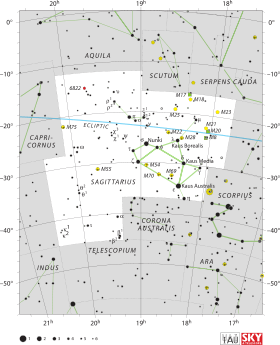Chi1 Sagittarii
 | |
| Observation data Epoch J2000.0 Equinox J2000.0 (ICRS) | |
|---|---|
| Constellation | Sagittarius |
| Right ascension | 19h 25m 16.49013s[1] |
| Declination | −24° 30′ 30.8599″[1] |
| Apparent magnitude (V) | +5.03[2] |
| Characteristics | |
| Spectral type | A3/5 IV/V[3] |
| B−V color index | +0.23[2] |
| Astrometry | |
| Radial velocity (Rv) | −43.4±1.6[4] km/s |
| Proper motion (μ) | RA: +61.63[1] mas/yr Dec.: −50.66[1] mas/yr |
| Parallax (π) | 12.95 ± 0.50[1] mas |
| Distance | 252 ± 10 ly (77 ± 3 pc) |
| Absolute magnitude (MV) | +0.59[5] |
| Orbit[6] | |
| Period (P) | 5.72 yr |
| Semi-major axis (a) | 0.069″ |
| Eccentricity (e) | 0.710 |
| Inclination (i) | 97.3° |
| Longitude of the node (Ω) | 259.0° |
| Periastron epoch (T) | 1984.29 |
| Argument of periastron (ω) (secondary) | 10.7° |
| Details | |
| Chi1 Sgr A | |
| Mass | 1.64[7] M☉ |
| Luminosity | 42.9[8] L☉ |
| Surface gravity (log g) | 4.15[7] cgs |
| Temperature | 7,859±267[7] K |
| Rotational velocity (v sin i) | 54[9] km/s |
| Age | 393[7] Myr |
| Other designations | |
| Database references | |
| SIMBAD | data |
Chi1 Sagittarii (χ1 Sagittarii) is a binary star[6] system in the zodiac constellation of Sagittarius. The pair have a combined apparent visual magnitude of +5.03,[2] which is bright enough to be seen with the naked eye. Based upon an annual parallax shift of 12.95 mas as seen from Earth,[1] it is located around 252 light years from the Sun. It is advancing through space in the general direction of the Earth with a radial velocity of −43.4 km/s.[4]
This is a visual binary with an orbital period of 5.72 years, an eccentricity of 0.710, and an angular semimajor axis of 69 mas. The primary, component A, is an A-type star showing a mixed spectrum that matches a stellar classification of A3/5 IV/V.[3] Helmut Abt classified it as an Am star with a spectral type of kA5hF0VmF0.[11] This notation indicates it has the calcium K-lines of an A5 star, and the hydrogen and metal lines of an F0 star. It is around 393[7] million years old and is spinning with a projected rotational velocity of 54 km/s.[9] The star has an estimated 1.6[7] times the mass of the Sun and is radiating 42.9[8] times the Sun's luminosity from its photosphere at an effective temperature of 7,859 K.[7]
References
- 1 2 3 4 5 6 van Leeuwen, F. (2007), "Validation of the new Hipparcos reduction", Astronomy and Astrophysics, 474 (2): 653–664, arXiv:0708.1752, Bibcode:2007A&A...474..653V, doi:10.1051/0004-6361:20078357.
- 1 2 3 Nicolet, B. (1978), "Photoelectric photometric Catalogue of homogeneous measurements in the UBV System", Astronomy and Astrophysics Supplement Series, 34: 1–49, Bibcode:1978A&AS...34....1N.
- 1 2 Houk, Nancy; Smith-Moore, M. (1978), Michigan catalogue of two-dimensional spectral types for the HD stars, 4, Ann Arbor: Dept. of Astronomy, University of Michigan, Bibcode:1988mcts.book.....H.
- 1 2 Kharchenko, N. V.; et al. (2007), "Astrophysical supplements to the ASCC-2.5: Ia. Radial velocities of ˜55000 stars and mean radial velocities of 516 Galactic open clusters and associations", Astronomische Nachrichten, 328 (9): 889–896, arXiv:0705.0878, Bibcode:2007AN....328..889K, doi:10.1002/asna.200710776.
- ↑ Anderson, E.; Francis, Ch. (2012), "XHIP: An extended hipparcos compilation", Astronomy Letters, 38 (5): 331, arXiv:1108.4971, Bibcode:2012AstL...38..331A, doi:10.1134/S1063773712050015.
- 1 2 "Sixth Catalog of Orbits of Visual Binary Stars". United States Naval Observatory. April 25, 2016. Retrieved 20 June 2017.
- 1 2 3 4 5 6 7 David, Trevor J.; Hillenbrand, Lynne A. (2015), "The Ages of Early-Type Stars: Strömgren Photometric Methods Calibrated, Validated, Tested, and Applied to Hosts and Prospective Hosts of Directly Imaged Exoplanets", The Astrophysical Journal, 804 (2): 146, arXiv:1501.03154, Bibcode:2015ApJ...804..146D, doi:10.1088/0004-637X/804/2/146.
- 1 2 McDonald, I.; et al. (2012), "Fundamental Parameters and Infrared Excesses of Hipparcos Stars", Monthly Notices of the Royal Astronomical Society, 427 (1): 343–57, arXiv:1208.2037, Bibcode:2012MNRAS.427..343M, doi:10.1111/j.1365-2966.2012.21873.x.
- 1 2 Royer, F.; et al. (February 2007), "Rotational velocities of A-type stars. III. Velocity distributions", Astronomy and Astrophysics, 463 (2): 671–682, arXiv:astro-ph/0610785, Bibcode:2007A&A...463..671R, doi:10.1051/0004-6361:20065224.
- ↑ "chi01 Sgr". SIMBAD. Centre de données astronomiques de Strasbourg. Retrieved 2017-07-05.
- ↑ Abt, H. A. (March 1981), "Visual multiples. VII - MK classifications", Astrophysical Journal Supplement Series, 45: 437–456, Bibcode:1981ApJS...45..437A, doi:10.1086/190719.